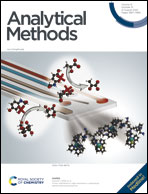A low-interference, high-resolution multianalyte electrochemical biosensor†
Abstract
Electrochemical sensors are used by millions of patients and health care providers every year, yet these measurements are hindered by compounds that also exhibit inherent redox activity. Acetaminophen (APAP) is one such interferent that falls into this extensive class. In this work, an osmium-based redox polymer was used for electrochemical detection in a sensor that was operated at a decreased voltage, allowing for decreased interference. These sensors demonstrated better selectivity (40-fold for glucose and 200-fold for lactate) for their respective analyte over APAP, possessed higher sensitivity (0.350 ± 0.006 μA mM−1 for glucose and 2.00 ± 0.05 μA mM−1 for lactate) over a broad range of analyte concentrations (50 μM–10 mM for glucose and 2–324 μM for lactate), and displayed similar operational stability (26% decrease for glucose and 29% decrease for lactate) over 7 days compared to first-generation sensors. To test this platform under biologically-relevant conditions, glucose metabolism was monitored in a model liver cell line, Alpha Mouse Liver 12 (AML12) after treatment with APAP and/or insulin. This work represents a high-resolution electrochemical biosensor for microphysiological monitoring of glucose and lactate in the presence of APAP.



 Please wait while we load your content...
Please wait while we load your content...
